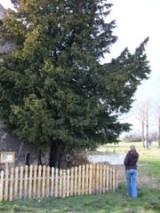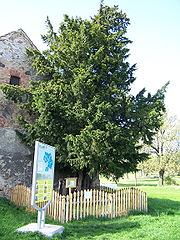
Henryków Lubanski
Encyclopedia
Henryków Lubański h is a village in the administrative district of Gmina Lubań
, within Lubań County
, Lower Silesian Voivodeship
, in south-western Poland. It lies approximately 7 kilometres (4 mi) north-west of Lubań
, and 124 kilometres (77 mi) west of the regional capital Wrocław. The village has a population of 850.
 The village contains Poland's oldest tree – a 1260-year-old yew
The village contains Poland's oldest tree – a 1260-year-old yew
, which is listed as a natural monument
.
Hennersdorf belonged to the historic Upper Lusatia
region, a Bohemian crown land
, and was a possession of the Magdalene
Abbey at Lauban
(Lubań). It remained Catholic, when the region turned Protestant
in the early 16th century and even after the Lusatias passed to Saxony
by the 1635 Peace of Prague
. In 1745, the village was the site of the Battle of Hennersdorf
between the Prussian Army
under General Hans Joachim von Zieten
and a Saxon contingent in the War of the Austrian Succession
. Upon the implementation of the Oder-Neisse line
in 1945, the region became part of the Republic of Poland
in 1945.
The St. Nicholas
Church is a stop on the Lower Silesian route of the Way of St. James
.
Gmina Luban
Gmina Lubań is a rural gmina in Lubań County, Lower Silesian Voivodeship, in south-western Poland. Its seat is the town of Lubań, although the town is not part of the territory of the gmina....
, within Lubań County
Luban County
Lubań County is a unit of territorial administration and local government in Lower Silesian Voivodeship, south-western Poland. It came into being on January 1, 1999, as a result of the Polish local government reforms passed in 1998. The county covers an area of . Its administrative seat and...
, Lower Silesian Voivodeship
Lower Silesian Voivodeship
Lower Silesian Voivodeship, or Lower Silesia Province , is one of the 16 voivodeships into which Poland is currently divided. It lies in southwestern Poland...
, in south-western Poland. It lies approximately 7 kilometres (4 mi) north-west of Lubań
Luban
Lubań is a town in southwest Poland north of the Jizera Mountains on the Kwisa river, with 22,137 inhabitants . Situated within the historic Upper Lusatia region, it today belongs to the Lower Silesian Voivodeship...
, and 124 kilometres (77 mi) west of the regional capital Wrocław. The village has a population of 850.

Taxus baccata
Taxus baccata is a conifer native to western, central and southern Europe, northwest Africa, northern Iran and southwest Asia. It is the tree originally known as yew, though with other related trees becoming known, it may be now known as the English yew, or European yew.-Description:It is a small-...
, which is listed as a natural monument
Natural Monument
A natural monument is a natural or natural/cultural feature of outstanding or unique value because of its inherent rarity, representative of aesthetic qualities or cultural significance....
.
Hennersdorf belonged to the historic Upper Lusatia
Upper Lusatia
Upper Lusatia is a region a biggest part of which belongs to Saxony, a small eastern part belongs to Poland, the northern part to Brandenburg. In Saxony, Upper Lusatia comprises roughly the districts of Bautzen and Görlitz , in Brandenburg the southern part of district Oberspreewald-Lausitz...
region, a Bohemian crown land
Lands of the Bohemian Crown
The Lands of the Bohemian Crown , also called the Lands of the Crown of Saint Wenceslas or simply the Bohemian Crown or Czech Crown lands , refers to the area connected by feudal relations under the joint rule of the Bohemian kings...
, and was a possession of the Magdalene
Mary Magdalene
Mary Magdalene was one of Jesus' most celebrated disciples, and the most important woman disciple in the movement of Jesus. Jesus cleansed her of "seven demons", conventionally interpreted as referring to complex illnesses...
Abbey at Lauban
Luban
Lubań is a town in southwest Poland north of the Jizera Mountains on the Kwisa river, with 22,137 inhabitants . Situated within the historic Upper Lusatia region, it today belongs to the Lower Silesian Voivodeship...
(Lubań). It remained Catholic, when the region turned Protestant
Protestant Reformation
The Protestant Reformation was a 16th-century split within Western Christianity initiated by Martin Luther, John Calvin and other early Protestants. The efforts of the self-described "reformers", who objected to the doctrines, rituals and ecclesiastical structure of the Roman Catholic Church, led...
in the early 16th century and even after the Lusatias passed to Saxony
Electorate of Saxony
The Electorate of Saxony , sometimes referred to as Upper Saxony, was a State of the Holy Roman Empire. It was established when Emperor Charles IV raised the Ascanian duchy of Saxe-Wittenberg to the status of an Electorate by the Golden Bull of 1356...
by the 1635 Peace of Prague
Peace of Prague (1635)
The Peace of Prague of 30 May 1635 was a treaty between the Habsburg Emperor Ferdinand II and the Electorate of Saxony representing most of the Protestant states of the Holy Roman Empire...
. In 1745, the village was the site of the Battle of Hennersdorf
Battle of Hennersdorf
The Battle of Hennersdorf, sometimes referred to as Catholic-Hennersdorf, was a minor encounter that took place on November 23, 1745 in Katholisch-Hennersdorf in Silesia during the War of the Austrian Succession. The Prussians under Frederick II defeated the Austrians under Prince Charles...
between the Prussian Army
Prussian Army
The Royal Prussian Army was the army of the Kingdom of Prussia. It was vital to the development of Brandenburg-Prussia as a European power.The Prussian Army had its roots in the meager mercenary forces of Brandenburg during the Thirty Years' War...
under General Hans Joachim von Zieten
Hans Joachim von Zieten
Hans Joachim von Zieten , also known as Zieten aus dem Busch, was a cavalry general in the Prussian Army...
and a Saxon contingent in the War of the Austrian Succession
War of the Austrian Succession
The War of the Austrian Succession – including King George's War in North America, the Anglo-Spanish War of Jenkins' Ear, and two of the three Silesian wars – involved most of the powers of Europe over the question of Maria Theresa's succession to the realms of the House of Habsburg.The...
. Upon the implementation of the Oder-Neisse line
Oder-Neisse line
The Oder–Neisse line is the border between Germany and Poland which was drawn in the aftermath of World War II. The line is formed primarily by the Oder and Lusatian Neisse rivers, and meets the Baltic Sea west of the seaport cities of Szczecin and Świnoujście...
in 1945, the region became part of the Republic of Poland
People's Republic of Poland
The People's Republic of Poland was the official name of Poland from 1952 to 1990. Although the Soviet Union took control of the country immediately after the liberation from Nazi Germany in 1944, the name of the state was not changed until eight years later...
in 1945.
The St. Nicholas
Saint Nicholas
Saint Nicholas , also called Nikolaos of Myra, was a historic 4th-century saint and Greek Bishop of Myra . Because of the many miracles attributed to his intercession, he is also known as Nikolaos the Wonderworker...
Church is a stop on the Lower Silesian route of the Way of St. James
Way of St. James (route descriptions)
The Way of St. James extends from all corners of Europe, and even North Africa, on its way to Santiago de Compostela and Finisterre.The local authorities try to restore many of the ancient routes, even those used in a limited period, in the interest of tourism....
.

